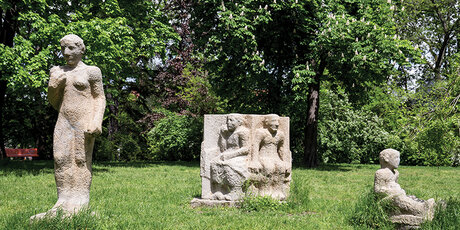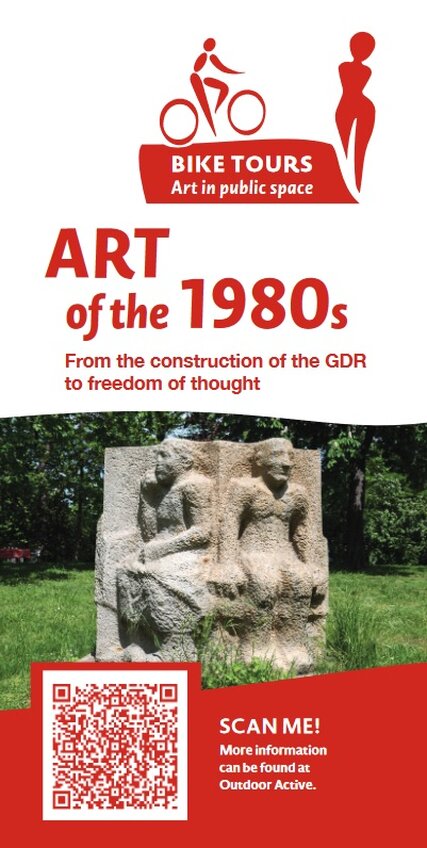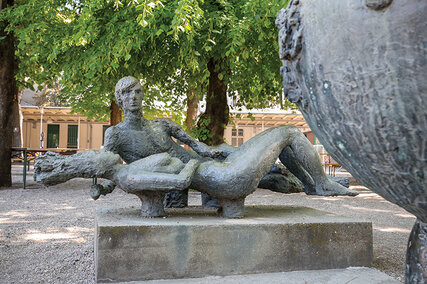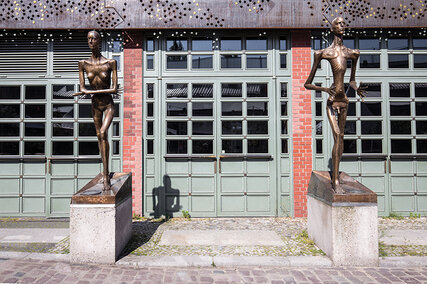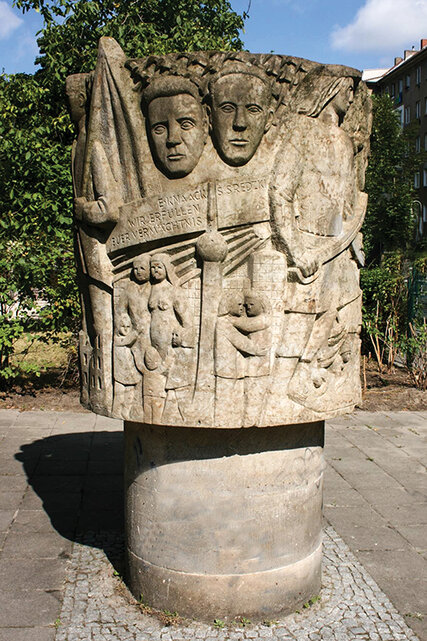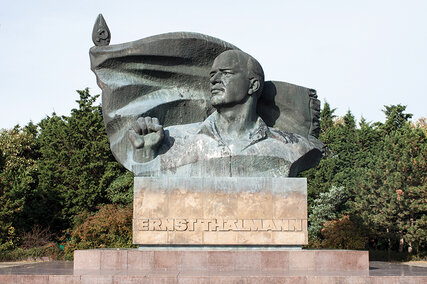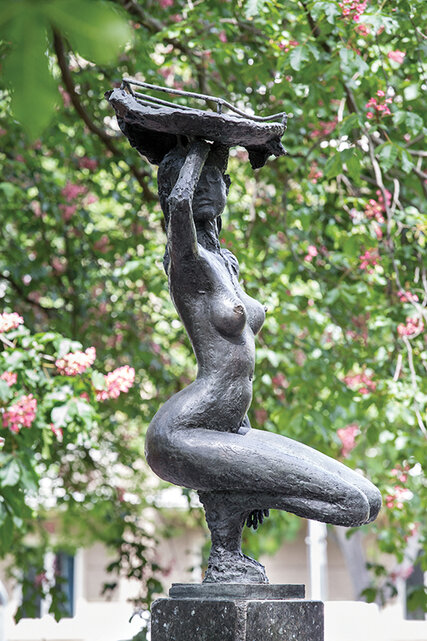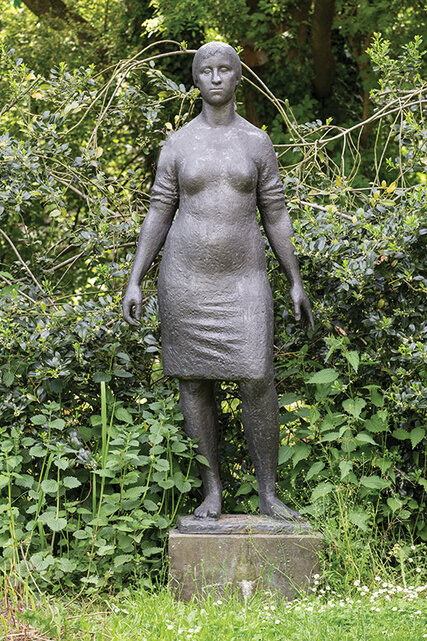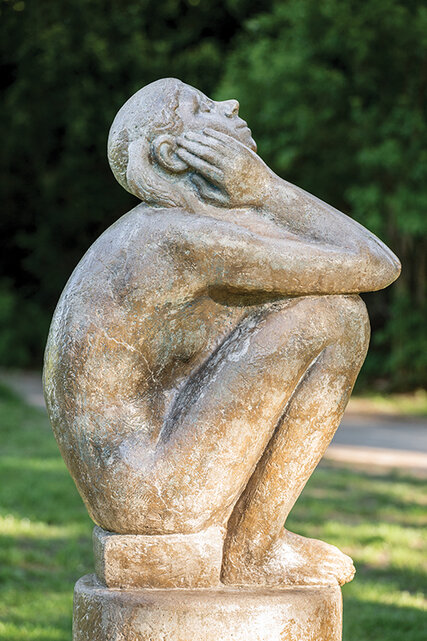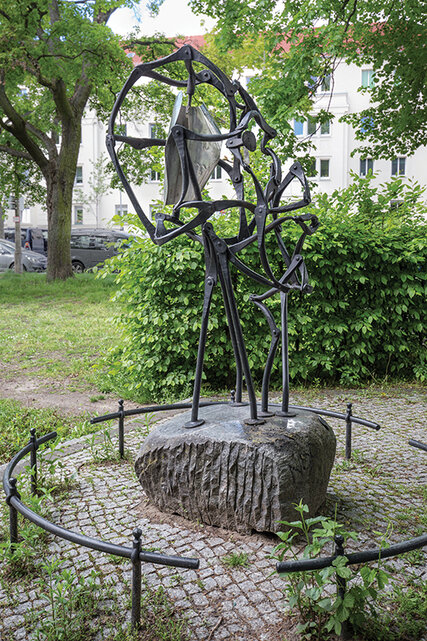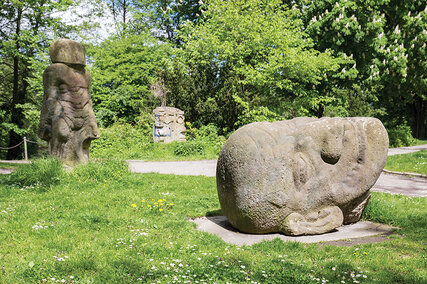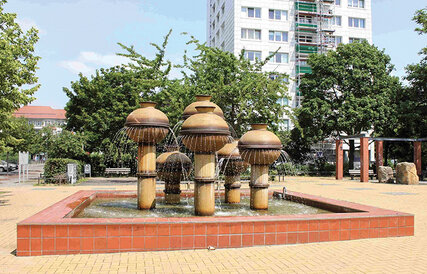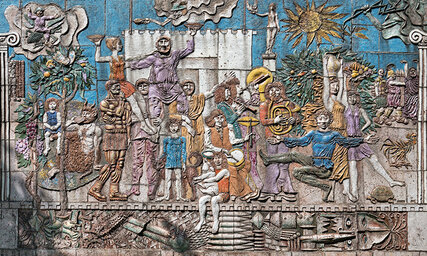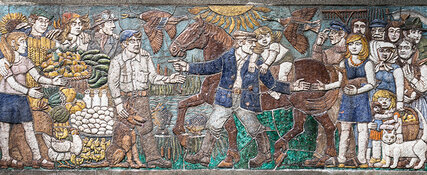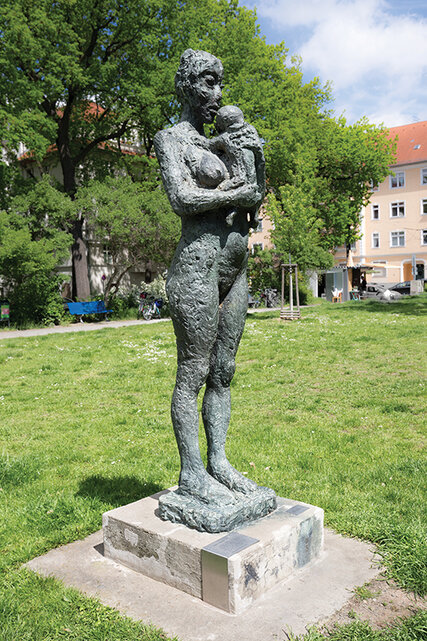ART oft he 1980s – From the constuction oft he GDR to freedom of thought
Berlin has a long tradition of artistic engagement with public spaces, buildings, and civil engineering works. As a result, a plethora of sculptures, murals, statues can be found throughout the city. Some objects are hidden; others are placed prominently on walls, in parks, or on streets. Public artworks allow people to encounter art outside museums and function as open invitations to explore their meaning and revel in their wonders. Pankow and Lichtenberg offer public art tours by foot or bike. Participants learn about the creation of the works and their materials along with the social background, life, and output of the artists themselves.
The tour takes you through the Berlin districts of Pankow, Weißensee, Prenzlauer Berg, and Lichtenberg. Along the way you will see an array of statues, sculptures, reliefs, and fountain designs – though the focus will lie on East German sculpture from the 1980s. We have chosen this period because by that time the GDR had relaxed its strict codes governing artistic expression, giving artists more creative freedom than in previous decades. Some artists managed to embed critical messages in their work and in quotes from writers and the old masters. Others created abstract works of art that only a few years earlier would have been publicly condemned for violating the tenets of realism and naturalism. To help you better understand the historical significance of public art in the 1980s, the tour also includes older works and works from aer reunification. The youngest work in the tour is a piece of art that would have been unrealizable in the GDR and that still feels relevant today.
Station 1: Liegendes Paar (Reclining Couple), Artist: Sabina Grzimek (*1942)
Location: Kastanienallee 7–9, Prater Garden, Liegendes Paar (Reclining Couple), Artist: Sabina Grzimek (*1942), Date: 1981, Material: bronze
In the middle of the Prater Garten, the oldest beer garden in Berlin, is the bronze sculpture Reclining Couple, by Sabina Grzimek. The couple seems suspended above the ground, blending harmoniously with its surroundings. The realistic representation has abstract details such as the rendering of the arms and feet. Typically for Grzimek, the surface of the sculpture expresses the inner movement of the gures. Next to the couple is a fountain bowl resting on an oval foot. Shaped like a goblet, the bowl suggests a drinking glass – but also a baptismal vessel. Indeed, the position of the woman and her hands hints at an unborn life; the owing water, its source.
Grzimek’s humanistic worldview is evident in her thematic approach to people. Her studies with important representatives of social realist sculpture in the GDR are reected in her naturalistic design. From 1962 to 1967, she studied at the University of Fine and Applied Arts Berlin-Weißensee with Heinrich Drake and Ludwig Engelhardt. From 1969 to 1972, she was a master class student of Fritz Cremer at the Academy of Arts of the GDR.
Station 2: Adam und Eva (Adam and Eve), Artist: Rolf Biebl (*1951)
Location: in front of the Engine House of the Kulturbrauerei, Knaackstraße 95–97, Adam und Eva (Adam and Eve), Artist: Rolf Biebl (*1951), Date: 1990, Material: bronze
The gures depict Adam and Eve in a surrealist style intended to address the differences between man and woman. While Eva pushes herself forward, arms crossed, in her neat, straight posture, Adam opens his bent arms expansively. Their bodies have thin and overly long limbs, as if they were slowly dissolving. When viewed from the side, the gures’ dynamic, expressive posture comes into full relief: it reects the unconditional will to strive forward.
Adam and Eve have been themes in Biebl’s sculptures since the 1980s. The thinning forms and volumes shows the conict between naturalistic rendering and alienation. The movement away from the body and towards real and imaginary space suggests a search for transcendence. In this, Biebl’s work alludes to the bronzes by the Swiss sculptor, painter, and graphic artist Alberto Giacometti. Biebl’s divergence from naturalism makes it incompatible with a people’s art, as it was taught and perceived in East Germany. Contradicting the gurative imperative of GDR cultural policy, his work reects the experimental possibilities that emerged in the late 1980s.
Station 3: Geschichte der deutschen Arbeiterbewegung (History of the German Labor Movement), Artist: Heinz Worner (1910–2008)
Location: Knaackstraße 53–67, in front of the elementary school on Kollwitzplatz, Geschichte der deutschen Arbeiterbewegung (History of the German Labor Movement), Artist: Heinz Worner (1910–2008), Date: 1981, Material: sandstone
The GDR began to erect memorials to the victims of war and tyranny in the 1950s. The memorial stele History of the German Labor Movement, located in front of the former Siegmund Sredzki High School, is modest in its design and placement. The compact, cylindrical basic shape exemplies much East German sculpture from the 1970s onwards. Its purpose was to confront students at the school with a historical mediation in keeping with the cultural politics of the GDR. The history of the German labor movement begins with the German Revolution of 1848/1849, with relief portraits of Karl Marx and Friedrich Engels and with scenes of barricade fights and mourning. It is followed by the depiction of the November Revolution of 1918 with portraits of Karl Liebknecht and Rosa Luxemburg and the victory over National Socialism in 1945. Ernst Knaack and Siegmund Sredzki, both antifascist resistance fighters, complete the history. At their feet is the ideal of a peaceful world, newly created aer 1949.
Station 4: Ernst Thälmann, Artist: Lew Kerbel (1917–2003)
Location: Ernst-Thälmann-Park, Ernst Thälmann, Artist: Lew Kerbel (1917–2003), Date: 1986, Material: bronze, granite (base)
The creator of the monumental monument, Lev Kerbel, was one of the most highly decorated artists in the Soviet Union. Aer the end of the Second World War, the Red Army commissioned him to commemorate the sacrices of the 1st Belarusian Front as they fought to liberate Berlin in early 1945. Ernst Thälmann was a port and transport worker from Hamburg who in 1925 became chairman of the Communist Party of Germany (KPD) and the Red Front Fighters Association (RFB). Its members greeted each other with the raised clenched st immortalized in the sculpture. Aer the KPD was banned in 1933, Thälmann was imprisoned for eleven years and murdered in the Buchenwald concentration camp. The 50-ton monument, erected on a base made of Ukrainian granite, was commissioned by SED party leadership on the occasion of Thälmann’s centenary. The sculpture required as much bronze as the GDR produced in a year. The sculpture has been a historical landmark since 1995.
In 2019, the district of Pankow announced a competition for an „artistic response” critically examining „the past and present of the Ernst Thälmann monument”. The winning project, Thinking from the Pedestal, by the artist Betina Kuntzsch, was completed in November 2021. Through images, lms and archival materials, it encourages visitors to linger at the site and reect on its greater signicance. More information about the artist and the work can be found at: www.element-video.de
Station 5: Knieende Dame mit Schale (Nackte vom Ostseeplatz) (Kneeling Lady with a Shell – The Naked Woman from Ostseeplatz), Artist: Anna Franziska Schwarzbach (*1949)
Location: Central promenade Ostseeplatz, Knieende Dame mit Schale (Nackte vom Ostseeplatz) (Kneeling Lady with a Shell – The Naked Woman from Ostseeplatz), Artist: Anna Franziska Schwarzbach (*1949), Date: 1990, Material: bronze
A nude young woman crouches while adroitly maintaining her balance in a posture of unmistakable grace. The interplay of the sculpture’s volumes and tectonic structures along the central axis is striking. The woman uses her right hand to balance a shallow bowl of rods on her head. She faces outward but turns slightly to the side, withdrawing back into herself. Typical for Schwarzbach’s bronzes, the surface is full of life – a far cry from the smooth, idealized surfaces common in the GDR a few decades earlier. The gure radiates calm and equilibrium yet also inner movement. To the east and west, stairs lead towards the sculpture but stop short. The gap prevents visitors who approach the gure from reaching it – a symbol of the woman’s inaccessibility.
Station 6: Aufbauhelferin (Female Reconstruction Volunteer), Artist: Eberhard Bachmann (1924–2008)
Location: Amalienstraße 26, Aufbauhelferin (Female Reconstruction Volunteer), Artist: Eberhard Bachmann (1924–2008), Date: installed in 1965/1968, Material: bronze
The bronze sculpture of a female reconstruction volunteer stands on a small green patch next to the Weißensee lake. The figure, rendered in the realistic style typical for the early years of East Germany, shows a woman who has just completed her work. She looks ahead condently, seemingly ready for the next task. The bronze sculpture can thus be read as a kind of resume for postwar reconstruction in the GDR.
The figure has a stocky, larger-than-life form. Her feet are bare – she quite literarily down-to-earth. Her headscarf and dress make a simple and functional uniform. The strong hands belong to a woman who works hard. Despite the dynamic posture the figure does not lift a foot. The sculpture honors all the volunteers who helped rebuild the country aer the war. It reects Bachmann’s studies with Heinrich Drake at the University of Fine and Applied Arts in Berlin-Weißensee.
Station 7: Hockende (Crouching Woman), Artist: Eberhard Bachmann (1924–2008)
Location: Oberseepark, Waldowstraße/Oberseestraße, Hockende (Crouching Woman), Artist: Eberhard Bachmann (1924–2008), Date: 1983/1985, Material: articial stone
The gure shows a young woman crouching on an oval column with her legs drawn up. Her face is turned towards the sun and her eyes are closed. The gure, also known as The Sun Worshiper, takes visible pleasure in the moment. The closed, self-contained body resembles an oval. The long, convex arch of the back stands in contrast to the triangle-shaped arms and legs. Bachmann’s work thematizes leisure and closeness to nature – suitable themes for the location – but also the contrast between tranquility and tension, corners and curves. The egg shape can be seen to symbolize new life.
In 1961, Bachmann began to teach sculpture at the University of Fine and Applied Arts in Berlin-Weißensee. Her students reported that her teaching was constructive, focused on the distinctions between the round and the domed, the convex and the concave –all elements that are instantly recognizable in her work.
Station 8: Die Gedanken sind frei (Thoughts Are Free), Artist: Gösta Gablick (*1966)
Location: Große-Leege-Str. 21, green area, Die Gedanken sind frei (Thoughts Are Free), Artist: Gösta Gablick (*1966), Date: 1996, Material: wrought iron and stainless steel
One of the most famous German folk songs begins „Thoughts are free ...”. Especially in times of political oppression, Germans have cited the line to express a longing for freedom and independence. It also found its way into the minds of artists who were particularly critical of the GDR regime.
At rst glance, the sculpture seems to be aconfused tangle of riveted and partly attened round bars. But as the eye rests on its lines, forms and movements emerge. The linked structure represents an abstract portrait head with a neck, an eye, a nose, an open mouth, and a prominent chin area. In the space within is a stainless-steel wind turbine. The shovels contain signs and the words from the German folk song. But Gablick puts the line in the context of the 1990s, where individual freedom expresses itself in sexuality. Here, Gablick anticipates a central paradigm of interpersonal relationships in the 21st century. The steel sculpture is located near the Berlin-Hohenschönhausen Memorial, a place of remembrance for political persecution in the Soviet occupation zone and in the GDR.
Station 9: David and Goliath, Artist: Rolf Biebl (*1951), Clemens Gröszer (1951–2014)
Location: Karl-Lade-Straße, green area south of the Fennpfuhl, Fennpfuhlpark, David and Goliath, Artist: Rolf Biebl (*1951), Clemens Gröszer (1951–2014), Date: 1987, Material: sandstone
The Old Testament story of David and Goliath has been an enduring metaphor for unequal struggle. On the ground rests a giant head, whose cheek, nose, and chin jut out prominently. It is Goliath in the nal throes of life. David stands a few meters away, marveling at his accomplishment. His arms hang at his side, a sling in his le hand. The sculpture’s block-like construction, eshiness, facelessness and detailing suggest at once man and machine. As life drains from the prostrate Goliath, David stands upright with condence, his strength ascendant.
In 1987, the 2nd International Berlin Sculptor Symposium („The Poetry of the Big City”) took place in the Buch Palace Park. It is there that Rolf Biebl and Clemens Gröszer presented their David and Goliath. In March of 1988, the work was installed in Fennpfuhlpark. The exact meaning of the biblical reference is unclear. It is likely meant to signify the greater artistic freedom of younger artists compared with previous decades.
Station 10: Erben der Spartakuskämpfer (Heirs to the Spartacus Fighters), Artist: Emerita Pansowová (*1946)
Location: Rathauspark Lichtenberg, Erben der Spartakuskämpfer (Heirs to the Spartacus Fighters), Artist: Emerita Pansowová (*1946), Date: 1987, Material: sandstone
The ground-level installation of sculptures creates intimacy with the visitor. Their features are typical of physiognomic studies and symbolize the three phases in a person‘s life: childhood, adolescence, and old age. On the far right, a boy sits on the floor with his legs stretched out. He gazes into the distance as he explores his surroundings with curiosity and impartiality. On the far left is a life-size female nude. Her pose and slightly lowered gaze is that of young person who is no longer impartial. A bench with an elderly couple stands between the female figure and the boy. The man and woman look around attentively, exuding a calmness appropriate to their age.
The group of figures lies across from Hans Fussel’s 1978 Blood Wall, which served in the GDR as a memorial for the Spartacus revolutionaries who were murdered here in March 1919. The title and theme were specied by the East German state, but the design was open to interpretation. This was common for art in the 1980s, which received more leeway from the state than art in previous decades.
Station 11: Keramikbrunnen (Ceramic Fountain), Artist: Rudolf Kaiser (1910–1980)
Location: Frankfurter Allee 144 / Schulze-Boysen-Straße, Keramikbrunnen (Ceramic Fountain), Artist: Rudolf Kaiser (1910–1980), Date: 1976/2012, Material: ceramic, clinker brick, articial stone
The Ceramic Fountain arose as part of an East German urban planning project in Berlin’s Lichtenberg district. Situated between highrise buildings, department stores, schools and kindergartens, the fountain square is a place for residents and passersby to relax as they enjoy the surrounding plants and trees. The owing water serves to invigorate and calm. Its freshness and purity enrich the square and drown out the noises of the city. The fountain, which sits in a square frame made of articial stone and red-brown ceramic tiles, has six spouts spiraling upward from shortest to tallest. The 1976 original by Rudolf Kaiser had a similar pattern and was originally designed to resemble a rainforest. Aer being damaged several times, it was rebuilt with a new design in 2012. Though the proportions and shapes have changed, with a little imagination it is still possible to picture Kaiser’s original.
Starting in the early 1960s, new pedestrian zones and town squares in the GDR were punctuated by sculptures, sculptures, and modern fountains. The fountains were often imaginatively designed – works of art in themselves. Their interplay of forms is a testament to artistic drive in the GDR.
Station 12:Bocaccio – Der Frieden (The Peace), Artist: Werner Petrich (1927–2017) andOle Bienkopp – Sommernachtstraum (Midsummer Night’s Dream), Artist: Hanfried Schulz (1922–2005)
Location: Harnackstraße 10, Bocaccio – Der Frieden (The Peace), Artist: Werner Petrich (1927–2017) and Ole Bienkopp – Sommernachtstraum (Midsummer Night’s Dream), Artist: Hanfried Schulz (1922–2005), Date: 1975, Material: concrete beams with polychrome mosaic decor
Somewhat hidden under trees are two large-format works of art that, with their rich imagery and fascinating colors, invite you on a journey into the history of theater, literature, and art. On the left is the mosaic stele Bocaccio – The Peace, by Werner Petrich. The stele features scenes from Peter Hacks’s play Der Frieden. The play’s protagonist, the Greek winemaker Trygaios, flies to Zeus on a dung beetle to bring about an end to warfare. The plan works and Trygaios is celebrated as a hero of peace. In the center of the stele is a portrayal of the nal scene of the play: Trygaios’s marriage to Opora, the goddess of ripe fruit. On the left, atop a branch of a pomegranate tree, is probably Persephone, the daughter of Zeus. The roots of the tree reach into the underworld, where the instruments of war lie buried.
On the left panel, a dove, the symbol of peace in the GDR, crowns Peter Hacks and Aristophanes. The narrow right-side panel shows the poet Giovanni Boccaccio. The backside features a masterpiece, The Birth of Venus, by Sandro Botticelli. A major exponent of the early Italian Renaissance, Botticelli revived the motif of Venus, the Roman goddess of love and beauty. As Venus rises from the sea, several secular scenes await her on land: monastery life, human love, drunkenness, and the discovery of the world by seafarers.
On the right side is the stele Ole Bienkopp – Midsummer Night’s Dream by Hanfried Schulz. The front shows a plot from the 1963 novel by Erwin Strittmatter. The stubborn farmer Ole stands in front of a horse and tries to mediate between two groups at the advent of collective farming in the GDR. The farmers on his right resist the new system. One man taps his forehead in indignation. On his left, supporters of collective farming rejoice at their abundant harvest. On the right is the figure of William Shakespeare and a reference to his comedy A Midsummer Night’s Dream.
These works of Werner Petrich and Hanfried Schulz artfully combine the themes of love, comedy, and tragedy. Like other GDR artists, they interpreted old masters and thinkers, from ancient times to the Renaissance. In so doing, they addressed themes such as decadence, rebelliousness, and the idea of freedom and related them to East German reality.
Station 13: Mutter mit Kind (Mother with Child), Artist: Sabina Grzimek (*1942)
Location: Freiaplatz/Rüdigerstraße, Mutter mit Kind (Mother with Child), Artist: Sabina Grzimek (*1942), Date: 1984, Material: bronze
Our last station is a bronze statue that stands upright, both feet planted rmly on the base. The even distribution creates balance and lends the gure a static center. The mother’s le arm is angled forward, directing her gaze to the child’s head. The mother’s right hand holds the child while leading the viewer’s eye back to her shoulder. The interaction between mother and child is intimate, and the modelling of the sculpture, particularly the mother’s head, gives the surface an animate quality. The mother’s natural physique reects not only Grzimek’s humanist ideals but also her study of realistic sculpture in the GDR. The bronze sculpture is dedicated to the resistance ghter Liselotte Herrmann (1909–1938). Communist resistance ghters and human existence were common themes in the GDR. In her work, Grzimek sought to preserve gurative representation, but she distanced herself from the social realist principles that held sway in the GDR.
